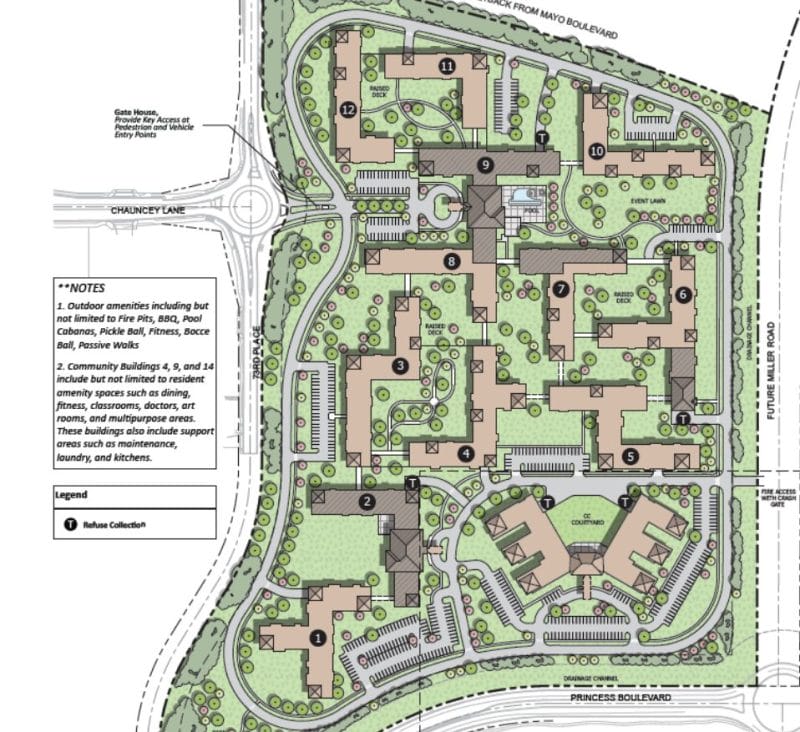By Paul Basha, traffic engineer, Summit Land Management
What is the “Michigan Left-Turn” I have heard discussed?
In the past dozen years, various agencies in developing portions of metropolitan Phoenix have discussed the “Michigan Left-Turn”. Michigan Left-turns were first created in Michigan in the early 1960’s. They are also called “Indirect Left-Turns”. The primary characteristic of Indirect Left-turns is prohibition of left-turns, requiring a right-turn-u-turn combination as a replacement.

The red dashed arrow provides the alternative to the prohibited eastbound-to-northbound leftturn by an eastbound-to westbound u-turn followed by a westbound-to-northbound right-turn.
The blue dotted arrow provides the alternative to the prohibited northbound-to-westbound leftturn by a northbound-to-eastbound right-turn followed by an eastbound-to westbound u-turn.
Typically, the mirror image is also provided for alternatives to prohibited westbound-tosouthbound left-turns and southbound-to-eastbound left-turns.
Some Arizona agencies have incorporated this intersection operation into their guidelines or requirements – typically by classifying the street as a “Parkway”.
One disadvantage of Michigan Left-turns is the requirement of an 80-foot wide median to accommodate the u-turn. However, Michigan Left-turns are much safer and much more efficient than typical intersections.
A major difficulty with Indirect Left-turns is that driveways cannot occur between the u-turn routes. If driveways exist, then the weaving movement between the right-turn and u-turn become much more complicated and collision-causing. Michigan Left-turns are only feasible in exurban areas. Exurban is an area between suburban and rural, that is not part of a metropolitan area.
Apache Junction, Maricopa, and Wickenburg decades ago were exurban areas; no longer; they are now part of metropolitan Phoenix. Sacaton, Stanfield, Coolidge, Florence, Dewey-Humboldt, Mayer, and Chino Valley are examples of Arizona exurban areas. As exurban areas become suburbs or mid-sized cities, the indirect left-turn intersection can function well . . . provided driveways are excluded in the vicinity of the intersections.
The parkways planned in Buckeye, Surprise, and Maricopa will only be successful in the future, if driveways between the u-turn routes are prohibited. Seems easy, though the property and business owner pressure will be intense. The excuse will be that there is no congestion at the intersections, so one driveway will not cause difficulties. Wrong.
The aerial photograph is a very successful 50-year-old indirect left-turn intersection in Marquette, Michigan. This Indirect Left-turn intersection includes traffic signals, which is common, though not necessary.

Left-turns cause problems. There are three opposing approaches of conflicting traffic. For a northbound-to-westbound left-turn; the southbound through, the southbound-to-westbound right-turn, the westbound through, the westbound-to-southbound left-turn, the eastbound through, and the eastbound-to-northbound left-turn all conflict. The east and west movement conflicts can be resolved with a traffic signal. However, the southbound through movement conflict can only be resolved with a protected-only left-turn arrow. Consider the obvious, a green light for some vehicles is a red light for other vehicles. Furthermore, left-turn arrows are usually a green arrow for a few vehicles and a red light for many vehicles.
Indirect Left-turns eliminate turn conflicts. By definition, they are safer. Also, they can often eliminate the need for a traffic signal – which is much more efficient for all movements. Parkways – streets with only indirect left-turns – have a 40% greater traffic capacity compared to streets with typical intersections. This higher capacity compensates for the 80-foot wide median. A two-lane-per-direction street with only Michigan Left-turns has a similar capacity to a three-lane-per-direction street with typical signalized intersections.
Yep, always trust them Michigan traffic engineers – they are the best!!
Curious about something traffic? Call or e-mail Paul at (480) 505-3931 and pbasha@summitlandmgmt.com.








